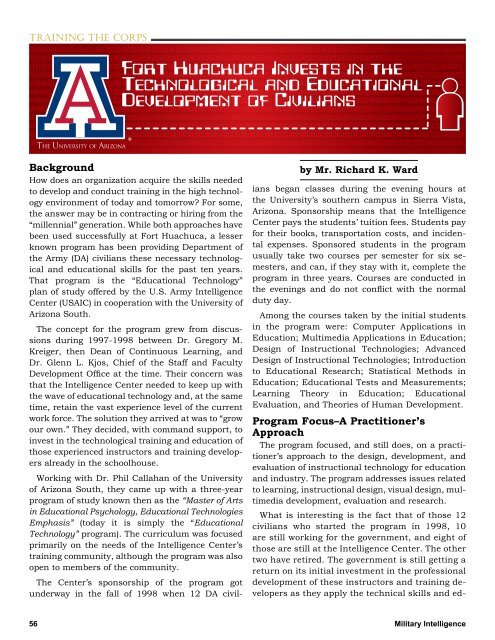Military Intelligence Professional Bulletin - Federation of American ...
Military Intelligence Professional Bulletin - Federation of American ...
Military Intelligence Professional Bulletin - Federation of American ...
You also want an ePaper? Increase the reach of your titles
YUMPU automatically turns print PDFs into web optimized ePapers that Google loves.
trAInInG tHE COrPs<br />
01001001001010010010111001010010010100100100101001001001010101010010010010101010100100100101010101001001001010101010010010010101010100100100101010<br />
01010101001001001010010101010010010010100101010100100100101001010101001001001010010101010010010010100101010100100100101001010101001001001010010101<br />
1111101001000100010010000001001001001000100000000000000101001000100100010001000100101000100010101010010010010100100100101001001010010101010101010<br />
01001001001010010010111001010010010100100100101001001001010101010010010010101010100100100101010101001001001010101010010010010101010100100100101010<br />
01010101001001001010010101010010010010100101010100100100101001010101001001001010010101010010010010100101010100100100101001010101001001001010010101<br />
01001001001010010010111001010010010100100100101001001001010101010010010010101010100100100101010101001001001010101010010010010101010100100100101010<br />
01010101001001001010010101010010010010100101010100100100101001010101001001001010010101010010010010100101010100100100101001010101001001001010010101<br />
0001001001001010010000000000000000000111010100101000000000010101110101010010010001001000001000010101010101010000100100101001010001001010001010010<br />
1111101001000100010010000001001001001000100000000000000101001000100100010001000100101000100010101010010010010100100100101001001010010101010101010<br />
01001001001010010010111001010010010100100100101001001001010101010010010010101010100100100101010101001001001010101010010010010101010100100100101010<br />
01010101001001001010010101010010010010100101010100100100101001010101001001001010010101010010010010100101010100100100101001010101001001001010010101<br />
0001001001001010010000000000000000000111010100101000000000010101110101010010010001001000001000010101010101010000100100101001010001001010001010010<br />
The University <strong>of</strong> Arizona<br />
1111101001000100010010000001001001001000100000000000000101001000100100010001000100101000100010101010010010010100100100101001001010010101010101010<br />
Background<br />
How does an organization acquire the skills needed<br />
to develop and conduct training in the high technology<br />
environment <strong>of</strong> today and tomorrow? For some,<br />
the answer may be in contracting or hiring from the<br />
“millennial” generation. While both approaches have<br />
been used successfully at Fort Huachuca, a lesser<br />
known program has been providing Department <strong>of</strong><br />
the Army (DA) civilians these necessary technological<br />
and educational skills for the past ten years.<br />
That program is the “Educational Technology”<br />
plan <strong>of</strong> study <strong>of</strong>fered by the U.S. Army <strong>Intelligence</strong><br />
Center (USAIC) in cooperation with the University <strong>of</strong><br />
Arizona South.<br />
The concept for the program grew from discussions<br />
during 1997-1998 between Dr. Gregory M.<br />
Kreiger, then Dean <strong>of</strong> Continuous Learning, and<br />
Dr. Glenn L. Kjos, Chief <strong>of</strong> the Staff and Faculty<br />
Development Office at the time. Their concern was<br />
that the <strong>Intelligence</strong> Center needed to keep up with<br />
the wave <strong>of</strong> educational technology and, at the same<br />
time, retain the vast experience level <strong>of</strong> the current<br />
work force. The solution they arrived at was to “grow<br />
our own.” They decided, with command support, to<br />
invest in the technological training and education <strong>of</strong><br />
those experienced instructors and training developers<br />
already in the schoolhouse.<br />
Working with Dr. Phil Callahan <strong>of</strong> the University<br />
<strong>of</strong> Arizona South, they came up with a three-year<br />
program <strong>of</strong> study known then as the “Master <strong>of</strong> Arts<br />
in Educational Psychology, Educational Technologies<br />
Emphasis” (today it is simply the “Educational<br />
Technology” program). The curriculum was focused<br />
primarily on the needs <strong>of</strong> the <strong>Intelligence</strong> Center’s<br />
training community, although the program was also<br />
open to members <strong>of</strong> the community.<br />
The Center’s sponsorship <strong>of</strong> the program got<br />
underway in the fall <strong>of</strong> 1998 when 12 DA civil-<br />
by Mr. Richard K. Ward<br />
ians began classes during the evening hours at<br />
the University’s southern campus in Sierra Vista,<br />
Arizona. Sponsorship means that the <strong>Intelligence</strong><br />
Center pays the students’ tuition fees. Students pay<br />
for their books, transportation costs, and incidental<br />
expenses. Sponsored students in the program<br />
usually take two courses per semester for six semesters,<br />
and can, if they stay with it, complete the<br />
program in three years. Courses are conducted in<br />
the evenings and do not conflict with the normal<br />
duty day.<br />
Among the courses taken by the initial students<br />
in the program were: Computer Applications in<br />
Education; Multimedia Applications in Education;<br />
Design <strong>of</strong> Instructional Technologies; Advanced<br />
Design <strong>of</strong> Instructional Technologies; Introduction<br />
to Educational Research; Statistical Methods in<br />
Education; Educational Tests and Measurements;<br />
Learning Theory in Education; Educational<br />
Evaluation, and Theories <strong>of</strong> Human Development.<br />
Program Focus–A Practitioner’s<br />
Approach<br />
The program focused, and still does, on a practitioner’s<br />
approach to the design, development, and<br />
evaluation <strong>of</strong> instructional technology for education<br />
and industry. The program addresses issues related<br />
to learning, instructional design, visual design, multimedia<br />
development, evaluation and research.<br />
What is interesting is the fact that <strong>of</strong> those 12<br />
civilians who started the program in 1998, 10<br />
are still working for the government, and eight <strong>of</strong><br />
those are still at the <strong>Intelligence</strong> Center. The other<br />
two have retired. The government is still getting a<br />
return on its initial investment in the pr<strong>of</strong>essional<br />
development <strong>of</strong> these instructors and training developers<br />
as they apply the technical skills and ed-<br />
56 <strong>Military</strong> <strong>Intelligence</strong>
















